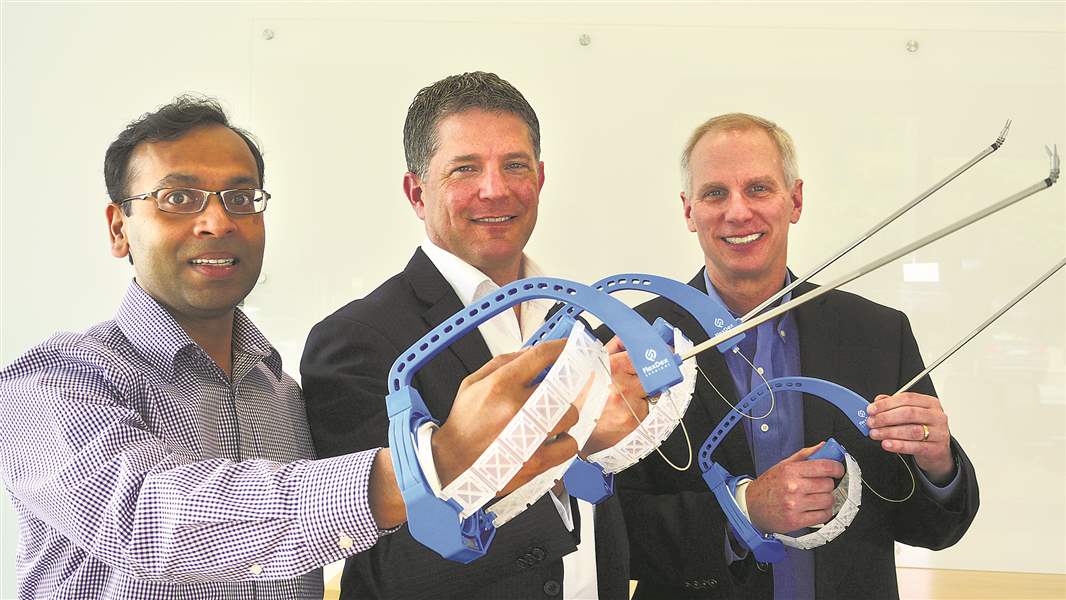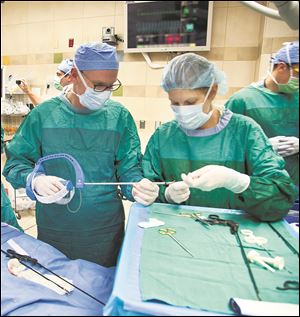
Toledoan helps create alternative to robotic surgery
Device designed to deliver precision suturing affordably
4/17/2017
FlexDex co-founders (from left), Shorya Awtar, Greg Bowles and James Geiger.
Marcin Szczepanski
A new surgical tool that combines the precision of robotic medicine with the affordability of traditional hand-held surgical instruments has the potential to change minimally invasive abdominal surgery, its inventors say.
That’s the idea behind FlexDex, a new device from its inventors at the University of Michigan, including pediatric surgeon and Toledo resident Dr. Jim Geiger. FlexDex mounts around a surgeon’s wrist and allows him to manipulate a suturing device at the end of an elongated stick through a small hole in a patient’s abdomen.

University of Michigan professor James Geiger use a FlexDex instrument for the first time in a surgery at the University of Michigan Hospital.
With the natural movements of a human wrist and hands, it provides full range of motion for laparoscopic, or minimally invasive surgeries, said Dr. Geiger, chief medical officer and co-founder of FlexDex Surgical, the company behind the new device.
“It has the potential to be a disruptive to [the practice of] minimally invasive surgery,” said Dr. Geiger, who is also a professor of surgery at the University of Michigan and surgeon at Mott Children’s Hospital in Ann Arbor.
“It’s a hand-held, purely mechanical surgical instrument that has full range of motion that your human wrist can do. Beyond what our human body can do,” he said. “It’s like almost having your hand in the patient through a very small incision. It has the same level of control over the straight stick [instrument],” but can be used without opening up a patient with a large incision.
But working through smaller incisions with more precision, comes at a significant cost, Dr. Geiger said. The popular Da Vinci robot, for instance, costs $2 million, which prices out many hospitals or can mean bigger medical bills for patients who do use them.
So Dr. Geiger joined Shorya Awtar, a mechanical engineering professor at Michigan and chief technology officer for FlexDex Surgical, and others to find a solution.
“We saw the need for more functional tools and instruments at an affordable price,” Mr. Awtar said. “Only 20 to 25 percent of U.S. hospitals have a robot, and outside the U.S. it’s only in some developed countries.”
Patients can benefit from minimally invasive surgery because it uses smaller incision and causes less pain, and patients can leave the hospital and return to work sooner, Dr. Geiger said. For physicians, using the device can mean less surgery-related fatigue than when using traditional instruments.
It can be used for any minimally invasive surgery, he said, including hernia repair, weight-loss surgery, or colon surgery, because it offers a similar level of functionality as robotics, without the substantial expense to buy and maintain the advanced technology.
While many major hospital systems in the United States — including the University of Michigan — have invested in robotic surgical tools, cost is one reason the practice hasn’t spread widely in other countries, Mr. Awtar said.
FlexDex could benefit hospitals in countries where robotic medicine is not widespread or financially feasible, or provide an extra tool for hospitals in the United States looking for alternatives to the substantial investment in robotic equipment, Dr. Geiger said.
“A lot of people have tried to make mechanical instruments that are articulated, but not in a natural way,” Dr. Geiger said.
“There is some learning to the [FlexDex] device, but once you do it’s like riding a bike.”

FlexDex co-founders (from left), Shorya Awtar, Greg Bowles and James Geiger.
Right now, the device is designed for a single use and costs $500 per instrument.
The latest version of FlexDex is for an instrument to suture and tie knots to close wounds, though Mr. Awtar said future plans call for detachable ends to accommodate various surgical tools.
And he sees applications beyond health care, as industries such as aeronautics and other engineering fields search for more precise instruments.
The project is a long time coming, inventors say, something FlexDex has been working on for about a decade. The company has received nearly $1.4 million in grant funding from the National Science Foundation and raised $7.4 million from investors, many of them from Toledo, Dr. Geiger said.
A second, more expansive product launch is expected in 2018.
Dr. Geiger said the company is getting calls from surgeons across the United States and internationally inquiring about the device.
It’s being used by surgeons in hospitals in Wisconsin and Hawaii, as well as in Michigan. Dr. Geiger said he’d like to see the device in Toledo hospitals soon as well.
“I can’t tell you how incredible the response from surgeons [has been],” Mr. Awtar said.
For more information about the device or the company, visit flexdex.com or email info@flexdexsurgical.com.
Contact Lauren Lindstrom at llindstrom@theblade.com, 419-724-6154, or on Twitter @lelindstrom.